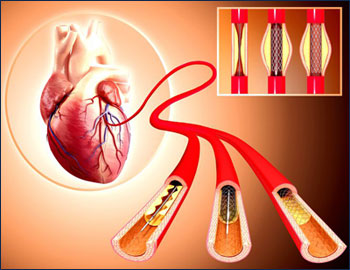
Dr. Suman Karmakar
MBBS ( Gold Medalist), Calcutta Medical College ( CMC), MD Internal Medicine, AIIMS, DM Cardiology, AIIMS

MBBS ( Gold Medalist), Calcutta Medical College ( CMC), MD Internal Medicine, AIIMS, DM Cardiology, AIIMS
A coronary angioplasty is a therapeutic procedure to treat the stenotic (narrowed) coronary arteries of the heart found in coronary heart disease. These stenotic segments are due to the build up of cholesterol-laden plaques that form due to atherosclerosis. A percutaneous coronary intervention is first performed.
A PCI used with stable coronary artery disease reduces chest pain but does not reduce the risk of death, myocardial infarction, or other major cardiovascular events when added to optimal medical therapy.

Coronary angioplasty, also called percutaneous coronaryintervention, is a procedure used to open clogged heart arteries. Angioplasty involves temporarily inserting and inflating a tiny balloon where your artery is clogged to help widen the artery.
Risks Related to Stents. About 1-2 percent of people who have stented arteries develop a blood clot at the stent site. Blood clots can cause a heart attack, stroke, or other serious problems. The risk of blood clots is greatest during the first few months after the stent is placed in the artery.
How long does coronary angioplasty take? If just one section of artery is widened, the procedure usually takes about 30 minutes. If several sections are to be widened then the procedure takes longer. You may need to stay in hospital overnight for observation following the procedure.
Angioplasty opens blocked arteries and restores normal blood flow to your heart muscle. It is not major surgery. With coronary angioplasty, a thin, expandable balloon is inserted into the clogged artery and is inflated.
As with all types of surgery, coronary angioplasty carries a risk of complications. However, the risk of serious problems is small. Complications can occur during or after an angioplasty. It's common to have bleeding or bruising under the skin where the catheter was inserted.
Peripheral angioplasty refers to the use of a balloon to open a blood vessel outside the coronary arteries. It is most commonly done to treat atherosclerotic narrowings of the abdomen, leg and renal arteries caused by peripheral artery disease. Often, peripheral angioplasty is used in conjunction with guide wire, peripheral stenting and an atherectomy.
After angioplasty, most patients are monitored overnight in the hospital, but if there are no complications, patients are sent home the following day.
The catheter site is checked for bleeding and swelling and the heart rate and blood pressure is monitored. Usually, patients receive medication that will relax them to protect the arteries against spasms. Patients are typically able to walk within two to six hours following the procedure and return to their normal routine by the following week.
Angioplasty recovery consists of avoiding physical activity for several days after the procedure. Patients are advised to avoid heavy lifting and strenuous activities for a week. Patients will need to avoid physical stress or prolonged sport activities for a maximum of two weeks after a delicate balloon angioplasty.
After the initial two week recovery phase, most angioplasty patients can begin to safely return to low-level exercise. A graduated exercise program is recommended whereby patients initially perform several short bouts of exercise each day, progressively increasing to one or two longer bouts of exercise. As a precaution, all structured exercise should be cleared by a cardiologist before commencing.
Patients with stents are usually prescribed an antiplatelet, clopidogrel, which is taken at the same time as acetylsalicylic acid (aspirin). These medicines are intended to prevent blood clots and they are usually taken for at least the first months after the procedure is performed. In most cases, patients are given these medicines for one year.
Patients who experience swelling, bleeding or pain at the insertion site, develop fever, feel faint or weak, notice a change in temperature or color in the arm or leg that was used or have shortness of breath or chest pain should immediately seek medical advice.
Angioplasty is a procedure to open narrowed or blocked blood vessels that supply blood to your legs. Fatty deposits can build up inside the arteries and block blood flow. A stent is a small, metal mesh tube that keeps the artery open. Angioplastyand stent placement are two ways to open blocked peripheral arteries.
Recovery from angioplasty and stenting is typically brief. Discharge from the hospital is usually 12 to 24 hours after the catheter is removed. Many patients are able to return to work within a few days to a week after a procedure.
Angioplasty does not cure the cause of the blockage in your arteries. Your arteries may become narrow again. Eat a heart-healthy diet, exercise, stop smoking (if yousmoke), and reduce stress to help lower your chances of having a blocked artery again.
Angioplasty is successful in opening coronary arteries in well over 90% of patients. Up to 30% to 40% of patients with successful coronary angioplasty will develop recurrent narrowing at the site of balloon inflation.